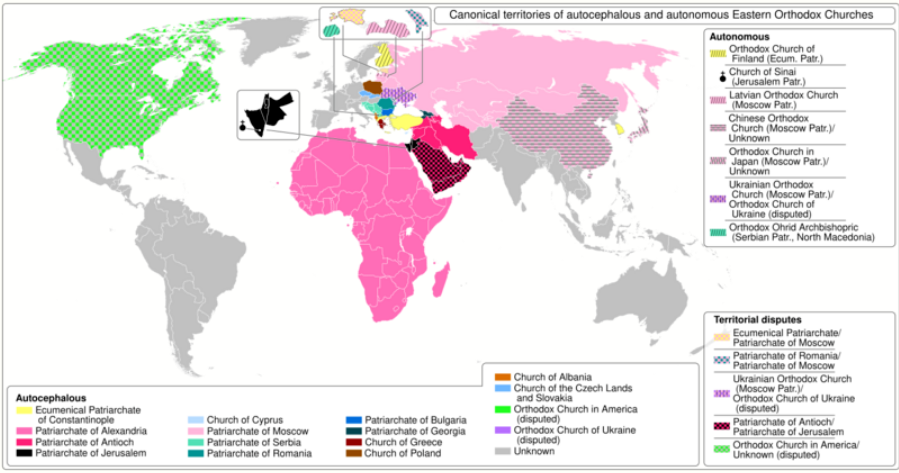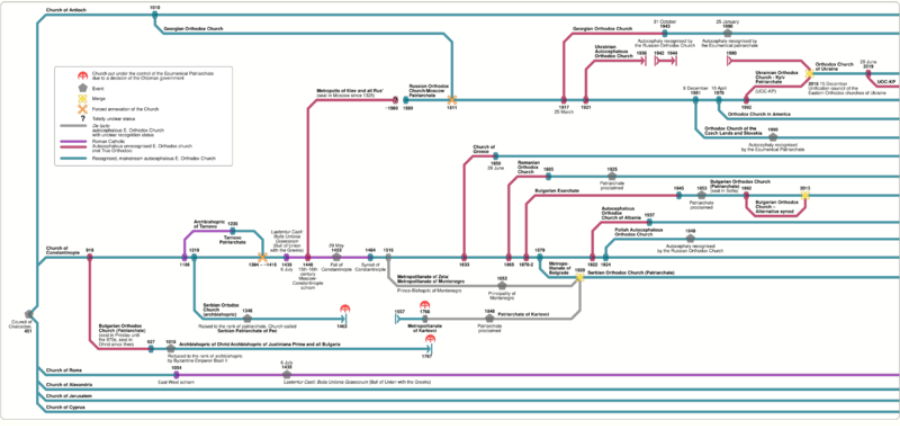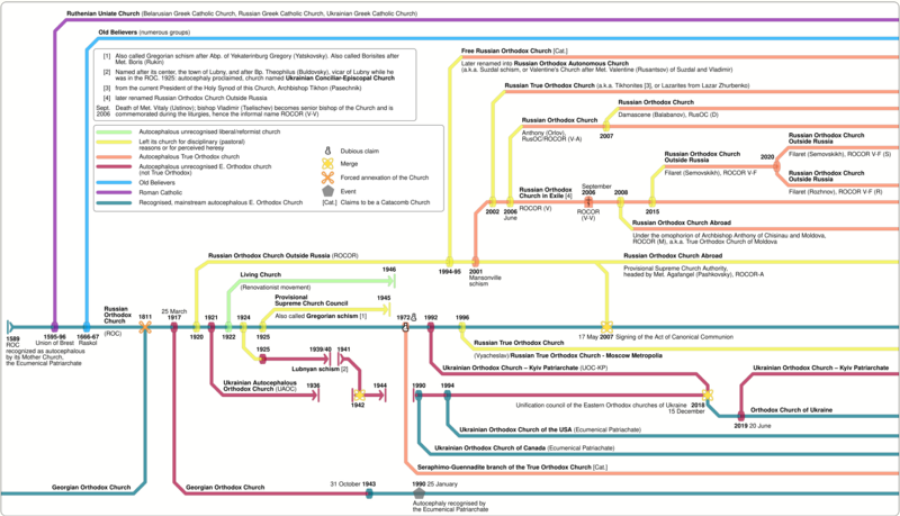
| Version | Summary | Created by | Modification | Content Size | Created at | Operation |
|---|---|---|---|---|---|---|
| 1 | Dean Liu | -- | 1679 | 2022-10-14 01:44:55 |
Video Upload Options
The Eastern Orthodox Church is a communion comprising the fourteen or sixteen separate autocephalous (self-governing) hierarchical churches that recognize each other as "canonical" Eastern Orthodox Christian churches. Each constituent church is self-governing; its highest-ranking bishop called the primate (a patriarch, a metropolitan or an archbishop) reports to no higher earthly authority. Each regional church is composed of constituent eparchies (or dioceses) ruled by bishops. Some autocephalous churches have given an eparchy or group of eparchies varying degrees of autonomy (limited self-government). Such autonomous churches maintain varying levels of dependence on their mother church, usually defined in a tomos or other document of autonomy. In many cases, autonomous churches are almost completely self-governing, with the mother church retaining only the right to appoint the highest-ranking bishop (often an archbishop or metropolitan) of the autonomous church. Normal governance is enacted through a synod of bishops within each church. In case of issues that go beyond the scope of a single church, multiple self-governing churches send representatives to a wider synod, sometimes wide enough to be called an Eastern Orthodox "ecumenical council". Such councils are deemed to have authority superior to that of any autocephalous church or its ranking bishop.
1. Church Governance
The Eastern Orthodox Church is decentralised, having no central authority, earthly head or a single bishop in a leadership role. Thus, the Eastern Orthoox use a synodical system canonically, which is significantly different from the hierarchical organisation of the Catholic Church that follows the doctrine of papal supremacy. References to the Ecumenical Patriarch of Constantinople as a leader are an erroneous interpretation of his title “first among equals".[1][2] His title is of honor rather than authority and in fact the Ecumenical Patriarch has no real authority over churches other than the Constantinopolitan.[3] His unique role often sees the Ecumenical Patriarch referred to as the "spiritual leader" of the Eastern Orthodox Church in some sources.
The autocephalous churches are normally in full communion with each other, so any priest of any of those churches may lawfully minister to any member of any of them, and no member of any is excluded from any form of worship in any of the others, including reception of the Eucharist.
In the early Middle Ages, the early Christian church was ruled by five patriarchs as the state church of Rome: the bishops of Rome, Constantinople, Alexandria, Antioch, and Jerusalem, collectively referred to as the Pentarchy. Each patriarch had jurisdiction over bishops in a specified geographic region. This continued until 927, when the autonomous Bulgarian Archbishopric became the first newly promoted patriarchate to join the original five.
The Patriarch of Rome was "first in place of honor" among the five patriarchs. Disagreement about the limits of his authority was one of the causes of the Great Schism, conventionally dated to the year 1054, which split the Church into the Catholic Church in the West, headed by the Bishop of Rome, and the Orthodox Church, led by the four eastern patriarchs (Constantinople, Jerusalem, Antioch and Alexandria). After the schism, this honorary primacy shifted to the Patriarch of Constantinople, who had previously been accorded second-place rank at the First Council of Constantinople.
In the 5th century, Oriental Orthodoxy separated from Chalcedonian Christianity (and is therefore separate from both the Eastern Orthodox and Catholic Church), well before the 11th century Great Schism. It should not be confused with Eastern Orthodoxy.
2. Jurisdictions

2.1. Autocephalous Eastern Orthodox Churches

Ranked in order of seniority, with the year of independence (autocephaly) given in parentheses, where applicable.[4][5] There are a total of 16 autocephalous Eastern Orthodox churches which are recognized.
Four ancient patriarchates
- Ecumenical Patriarchate of Constantinople (independence in 330 AD, elevated to the rank of autocephalous Patriarchate in 381)
- Greek Orthodox Church of Alexandria
- Greek Orthodox Church of Antioch
- Greek Orthodox Church of Jerusalem (independence in 451 AD, elevated to the rank of autocephalous Patriarchate in 451)
Those four ancient Eastern Orthodox Patriarchates are of the five episcopal sees forming the historical Pentarchy, the fifth one being the See of Rome. Those four Eastern Orthodox patriarchates remained in communion with each others after the 1054 schism.
The title of Patriarch was created in 531 by Justinian.[6]
Junior patriarchates
- Bulgarian Orthodox Church (870, Patriarchate since 918/919, recognized by the Patriarchate of Constantinople in 927[7])
- Georgian Orthodox Church
- Serbian Orthodox Church
- Russian Orthodox Church (1448, recognized in 1589[8][9])
- Romanian Orthodox Church (1872, recognized in 1885, Patriarchate since 1925)
Autocephalous archbishoprics
Note:[10]
- Church of Cyprus (recognized in 431)
- Church of Greece (1833, recognized in 1850)[11]
- Albanian Orthodox Church (1922, recognized in 1937)
Autocephalous metropolises
Note:[10]
- Polish Orthodox Church (1924)[12]
- Orthodox Church of the Czech Lands and Slovakia (1951)[13]
- Orthodox Church in America (1970, not recognized by the Ecumenical Patriarchate, but recognized by the Russian Orthodox Church and 5 other churches)[14]
- Orthodox Church of Ukraine (autocephaly from 15 December 2018, recognized by the Ecumenical Patriarchate on 5 January 2019, by the Church of Greece on 12 October 2019,[15][16][17] by the Patriarchate of Alexandria on 8 November 2019,[18][19][20][21] and by the Church of Cyprus on 24 October 2020[22][23][24])
The four ancient patriarchates are the most senior, followed by the five junior patriarchates. Autocephalous archbishoprics follow the patriarchates in seniority, with the Church of Cyprus being the only ancient one (AD 431). In the diptychs of the Russian Orthodox Church and some of its daughter churches (e.g., the Orthodox Church in America), the ranking of the five junior patriarchal churches is different. Following the Russian Church in rank is Georgian, followed by Serbian, Romanian, and then Bulgarian Church. The ranking of the archbishoprics is the same.
2.2. Autonomous Eastern Orthodox churches
- under the Ecumenical Patriarchate of Constantinople
- Self-governing Monastic Community of Mount Athos
- Estonian Apostolic Orthodox Church[25] (autonomy recognized by the Ecumenical Patriarchate but not by the Russian Orthodox Church)
- Orthodox Church of Finland
- under the Greek Orthodox Church of Antioch
- Antiochian Orthodox Christian Archdiocese of North America
- under the Greek Orthodox Church of Jerusalem
- Orthodox Church of Mount Sinai
- under the Russian Orthodox Church
- Belarusian Orthodox Church
- Latvian Orthodox Church
- Ukrainian Orthodox Church (Moscow Patriarchate)[25] (autonomy recognized by the Russian Orthodox Church but has no longer been recognized as such by the Ecumenical Patriarchate since October 2018, Patriarchate of Alexandria since November 2019, Church of Greece since August 2019, and Church of Cyprus since October 2020)
- Metropolis of Chișinău and All Moldova
- Orthodox Church in Japan[25] (autonomy recognized by the Russian Orthodox Church but not by the Ecumenical Patriarchate)
- Chinese Orthodox Church[25] (autonomy recognized by the Russian Orthodox Church but not by the Ecumenical Patriarchate)
- under the Serbian Orthodox Church
- Orthodox Ohrid Archbishopric
- under the Romanian Orthodox Church
- Metropolis of Bessarabia
- Romanian Orthodox Metropolis of the Americas
2.3. Semi-Autonomous Churches
- under the Ecumenical Patriarchate of Constantinople
- Church of Crete
- under the Russian Orthodox Church
- Estonian Orthodox Church of the Moscow Patriarchate[25]
- Russian Orthodox Church Outside Russia
2.4. Limited Self-Government (Not Autonomy)
- under the Ecumenical Patriarchate of Constantinople
- Greek Orthodox Archdiocese of Italy and Malta
- Korean Orthodox Church
- Exarchate of the Philippines
- American Carpatho-Russian Orthodox Diocese
- Ukrainian Orthodox Church of Canada
- Ukrainian Orthodox Church of the USA
- under the Russian Orthodox Church
- Archdiocese of Russian Orthodox churches in Western Europe
3. Unrecognized Churches

3.1. True Orthodox
These are churches that have separated from the mainstream communion over issues of Ecumenism and Calendar reform since the 1920s.[26] Due to what these churches perceive as being errors of modernism and the branch theory (which they call "ecumenism") in mainstream Eastern Orthodoxy, they refrain from concelebration of the Divine Liturgy with the mainstream Eastern Orthodox, while maintaining that they remain fully within the canonical boundaries of the Church: i.e., professing Eastern Orthodox belief, retaining legitimate apostolic succession, and existing in communities with historical continuity.
The churches which follow True Orthodoxy are:
- Old Calendar Bulgarian Orthodox Church
- Old Calendar Romanian Orthodox Church
- Serbian True Orthodox Church
- Russian True Orthodox Church (Lazar Zhurbenko)
- Russian Orthodox Autonomous Church
- Autonomous Orthodox Metropolia of North and South America and the British Isles
- True Orthodox Metropolis of Germany and Europe[27]
3.2. Unrecognized Churches that Voluntarily Stay Outside any Communion
These churches do not practice Communion with any other Eastern Orthodox jurisdictions nor do they tend to recognize each other. Yet, like the True Orthodox churches above, they consider themselves to be within the canonical boundaries of the Church: i.e., professing Eastern Orthodox belief, retaining what they believe to be legitimate apostolic succession, and existing in communities with historical continuity. Nevertheless, their relationship with all the other Eastern Orthodox churches remains unclear, as Eastern Orthodox churches normally recognize and are recognized by others.
- Greek Old Calendarists (with numerous churches)
- Russian Orthodox Church in America
3.3. Old Believers
Old Believers are divided into various churches which do not recognize each others, nor the mainstream Eastern Orthodox Church.
3.4. Churches That Are Not Recognized Despite Wanting to
The following churches recognize all other mainstream Eastern Orthodox churches, but are not recognized by any of them due to various disputes:
- Abkhazian Orthodox Church
- American Orthodox Catholic Church
- Belarusian Autocephalous Orthodox Church
- Association of Croatian Orthodox Believers (civic association)
- Macedonian Orthodox Church – Ohrid Archbishopric
- Montenegrin Orthodox Church
- Ukrainian Orthodox Church – Kyiv Patriarchate[28]
- Turkish Orthodox Church
3.5. Churches That Are Neither Recognized nor Fully Eastern Orthodox
The following churches use the term "Orthodox" in their name and carries belief or the traditions of Eastern Orthodox church, but blend beliefs and traditions from other denominations outside of Eastern Orthodoxy:
- Evangelical Orthodox Church (blends with Protestant - Evangelical and Charismatic - elements)
- Orthodox-Catholic Church of America (blends with Catholic and Oriental Orthodox elements)
- Nordic Catholic Church in Italy (originally called the Orthodox Church in Italy, it had ties with the UOC-KP; now associates with the Nordic Catholic Church and the Union of Scranton)
- Lusitanian Orthodox Church (blends with Catholic elements)
- Communion of Western Orthodox Churches (blends with Oriental Orthodox elements)
- Celtic Orthodox Church
- French Orthodox Church
- Orthodox Church of the Gauls
References
- Clark, Katherine (2009). Orthodox Church - Simple Guides (v3.1 ed.). London: Bravo Ltd. ISBN 978-1-85733-640-5. https://books.google.com/books?id=zbc-AQAAQBAJ&q=authority&pg=PT23. Retrieved 1 August 2015.
- "Autocephaly ( 6 of 20)". http://oca.org/questions/autocephaly/autocephaly-06.
- "Eastern Orthodoxy". Britannica. http://www.britannica.com/topic/Eastern-Orthodoxy#toc59581.
- Serbian Orthodox Church official site: Помесне Православне Цркве (Autocephalous Orthodox churches) http://www.spc.rs/eng/node/150
- Orthodox Church in America official site: World Churches http://oca.org/directories/world-churches
- "L'idea di pentarchia nella cristianità". homolaicus.com. http://www.homolaicus.com/storia/medioevo/pentarchia/pentarchia.htm.
- Kiminas, Demetrius (2009-03-01) (in en). The Ecumenical Patriarchate. Wildside Press LLC. pp. 15. ISBN 978-1-4344-5876-6. https://books.google.com/books?id=QLWqXrW2X-8C&lpg=PA2&ots=t4LMQbMa_B&dq=927+recognized+constantinople+bulgarian+patriarch&lr=&pg=PA15&redir_esc=y#v=onepage&q=927&f=false.
- Kiminas, Demetrius (2009-03-01) (in en). The Ecumenical Patriarchate. Wildside Press LLC. pp. 19. ISBN 978-1-4344-5876-6. https://books.google.com/books?id=QLWqXrW2X-8C&lpg=PA2&ots=t4LMQbMa_B.
- Due to the 2018 Moscow–Constantinople schism, the Russian Orthodox Church has cut ties with the Ecumenical Patriarchate along with several primates of other Churches on this list. The nature of their current relationship is uncertain
- In the E. Orthodox Churches of Greek tradition, the rank are, from the lowest to the highest, as follow: bishop, metropolitan, archbishop, patriarch. In contrast, in the other E. Orthodox Churches, the rank are, from the lowest to the highest, as follow: bishop, archbishop, metropolitan, patriarch. Thus, an archbishop from an E. Orthodox Church of Greek tradition is equivalent to a metropolitan in the other E. Orthodox Churches.
- "Church of Greece | national church" (in en). https://www.britannica.com/topic/Church-of-Greece.
- The primate of the Polish Orthodox Church is referred to as Archbishop of Warsaw and Metropolitan of All Poland , but the Polish Orthodox Church is officially a Metropolis[10] https://www.wikipedia.org/wiki/Poland
- The primate of the Czech and Slovak Orthodox Church is referred to as Archbishop of Prešov and Slovakia, Metropolitan of the Czech Lands and Slovakia, but the Czech and Slovak Orthodox Church is officially a Metropolis
- See Orthodox Church in America#Recognition of autocephaly
- "Η Εκκλησία της Ελλάδος αναγνώρισε την Αυτοκέφαλη Εκκλησία της Ουκρανίας". Eleutheros Typos. 12 October 2019. https://www.eleftherostypos.gr/ellada/472832-ektakto-i-ekklisia-tis-ellados-anagnorise-tin-ekklisia-tis-oykranias/.
- "It's Official: Church of Greece Recognizes the Autocephaly of the Orthodox Church of Ukraine". The Orthodox World. 12 October 2019. https://theorthodoxworld.com/its-official-church-of-greece-recognizes-the-autocephaly-of-the-orthodox-church-in-ukraine/.
- "The Church of Greece has recognized the Autocephalous Church of Ukraine (upd)" (in en-US). 2019-10-12. https://orthodoxtimes.com/the-church-of-greece-has-recognized-the-autocephalous-church-of-ukraine/.
- "Олександрійський патріархат визнав автокефалію ПЦУ". Ukrinform. 2019-11-08. https://www.ukrinform.com/rubric-society/2814373-oleksandrijskij-patriarhat-viznav-avtokefaliu-pcu.html.
- "Олександрійський патріархат визнав ПЦУ. Чому це важливо". BBC. 2019-11-08. https://www.bbc.com/ukrainian/news-50345287.
- "The Patriarchate of Alexandria recognizes the Autocephalous Church of Ukraine (upd)" (in en-US). 2019-11-08. https://orthodoxtimes.com/the-patriarchate-of-alexandria-recognizes-the-orthodox-church-of-ukraine/.
- "Letter sent by Patriarch Theodore to hierarchs on recognition of Ukrainian autocephaly" (in en-US). 2019-11-08. https://orthodoxtimes.com/letter-sent-by-patriarch-theodore-to-hierarchs-on-recognition-of-ukrainian-autocephaly/.
- "Кіпрська Церква визнала Православну Церкву України" (in uk). https://risu.ua/kiprska-cerkva-viznala-pravoslavnu-cerkvu-ukrayini_n112864.
- Online, Εκκλησία (2020-10-24). "Αρχιεπίσκοπος Κύπρου: Η απόφασή μου αυτή υπηρετεί την Ορθοδοξία" (in el). https://www.ekklisiaonline.gr/nea/archiepiskopos-kyprou-i-apofasi-mou-afti-ypireti-tin-orthodoxia/.
- "Archbishop of Cyprus commemorates Metropolitan Epifaniy of Kyiv for first time (upd)" (in en-US). 2020-10-24. https://orthodoxtimes.com/archbishop-of-cyprus-commemorates-metropolitan-epifaniy-of-kyiv-for-first-time/.
- Autonomy not universally recognised.
- Beoković, Jelena (1 May 2010). "Ko su ziloti, pravoslavni fundamentalisti". Politika. http://www.politika.rs/rubrike/Drustvo/Ko-su-ziloti-pravoslavni-fundamentalisti.lt.html.
- Was previously an Oriental Orthodox archdiocese by the Indian Orthodox Church and later an independent Oriental Orthodox Church; the Church is currently an autonomous True Orthodox Church under the Avlona Synod since 2016
- The UOC-KP merged into the Orthodox Church of Ukraine. However, the UOC-KP was re-established after a conflict between Patriarch Filaret and the primate of the OCU Metropolitan Epiphanius




